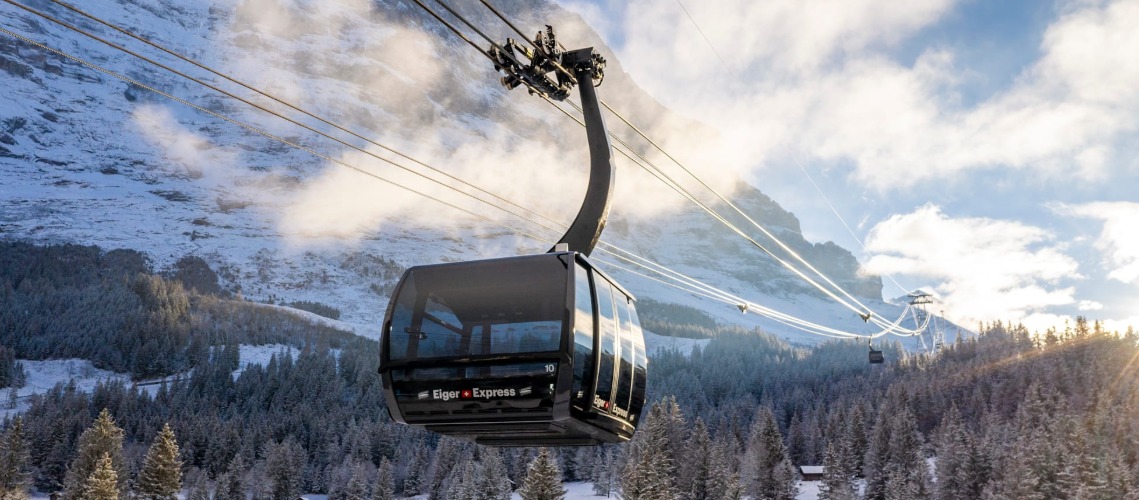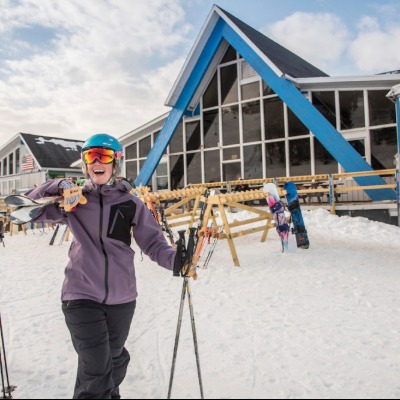ABB Announces Completion Grindelwald V-Bahn Project

The Eiger Express went into operation at the beginning of December 2020. The spectacular cable car leads from the Grindelwald Terminal to the Eigergletscher station and is the second arm of the V-Bahn. ABB contributed the drive solutions for the Eiger Express - as well as for the gondola lift on the Männlichen.
The view through the heated panorama windows of the cabins is unique. On the left the legendary Eiger north face. On the right the Lauberhorn. Behind the valley basin with Grindelwald. In front the Eigergletscher station, where you can either hit the slopes, the hiking trail or continue up to the Jungfraujoch.
The Eiger Express, also impresses with its technical data: the gondolas travel at a speed of 8 meters per second, i.e. almost 29 kilometers per hour. 6 meters per second is common. Passengers notice this at the latest when they rapidly enter the Eigergletscher station, where the gondola is braked in a controlled manner to the station speed. The train covers a distance of almost 6.5 kilometers and a difference in altitude of 1385 meters in just 15 minutes.
ABB supplied the drive solution for this spectacular cable car: four electric motors with an output of 500 kilowatts each, each driven by a regenerative frequency converter of the ACS 880 type.
"or our end customer, Jungfrau Railways, the maximum availability and reliability of the Eiger Express has top priority. Our group of companies decided to use motors and frequency converters from ABB. We are convinced of their quality and know ABB as a reliable partner from experience, ” said Raphael Reinle, the responsible project manager at Garaventa. Garaventa AG is the Swiss part of the Doppelmayr / Garaventa Group that realized the Eiger Express. Frey AG Stans, a subsidiary of the group, is responsible for the electrical control and has integrated the drive solution from ABB.
The layout with the four motors / frequency converters that are installed in the Eigergletscher station serves to ensure the availability of the railway. Even if one of these drive trains should fail, the Eiger Express continues. At the slightly slower speed of 6 meters per second, but at full capacity.
The 44 gondolas of the cable car can transport 2200 people per hour. “The system has to deliver the greatest output when parking out of the terminal in Grindelwald Grund, if there are no gondolas yet to counterbalance the valley,” explained Reinle. Dozens of ABB frequency converters are also used for the garage, with which the nacelles are protected from environmental influences at the end of operations.
16 regenerative ABB converters are also installed to accelerate and brake the gondolas at the mountain and valley stations. The resulting kinetic braking energy is converted into electrical energy and fed back into the network. With a fully occupied gondola, around 30 watt hours can be recuperated. The recovered braking energy in one cycle of the 44 gondolas - each of the mountain and valley stations - is around 2.5 kilowatt hours. Extrapolated over the entire year of operation, quite a bit of recuperated energy comes together.
The Eiger Express is a 3S cable car that combines the advantages of a gondola with those of an aerial tramway to create a detachable orbit. The two suspension ropes ensure high stability even in strong winds. “We were able to experience and confirm this live here on the opening day. The foehn blew at up to 100 kilometers per hour into the valley. It was really impressive how quiet the gondolas stayed. Inside we hardly felt anything from the storm wind, ”Reinle recalls.
These gondolas are currently the most modern cable car cabins in the world. The 26 seats can be heated, as can the panoramic glazing - so that the view remains unobstructed in winter. Two screens provide information to the passengers. The energy for this is generated by each nacelle itself, with newly developed roller generators. The eight rollers supply each cabin with 4 kilowatts of power on the way.
The Eiger Express is the second leg of the V-Bahn. It shares the modern Grindelwald Terminal, which is connected to the public rail network, with the Männlichenbahn, which opened at the end of 2019. With a length of 6100 meters, the 10-seater Grindelwald-Männlichen gondola lift replaced the old gondola lift from 1978 as part of the V-Bahn project. With 111 gondolas, it has doubled the transport capacity from 900 to 1800 guests per hour and the travel time of 30 minutes shortened to 19 minutes. It is driven by two 800 kilowatt motors from ABB, each with a regenerative frequency converter.
The term “generation project” does justice to the V-Bahn. Jungfrau Railways has invested a total of 470 million francs in the Bernese Oberland. This shortens the travel time to the Jungfraujoch by three quarters of an hour, which further increases the attractiveness of the "Jungfraujoch - Top of Europe" as a Swiss tourist highlight.
The construction time for the two railways was exactly 908 days. The opening of the Eiger Express, with which the project was completed, could even be brought forward by a week, despite corona-related challenges in 2020. This was made possible by good coordination among all companies involved. “ABB also delivered its motors and frequency converters absolutely on time,” Raphael Reinle draws a positive conclusion.













